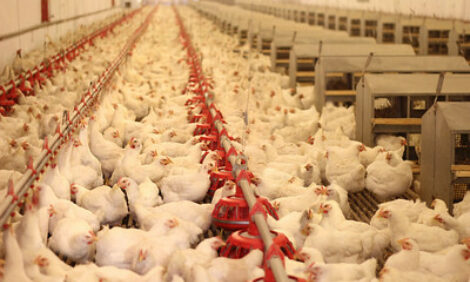



Natural Mating and Breeding
Extension poultry scientists from the University of Georgia explain mating behaviour in chickens and how this knowledge can be used to manage a breeding flock in the January 2009 issue of the University's Hatchery/Breeder Tips.Fertilization in commercial chickens is usually the result of natural mating. However, in some cases, artificial insemination is commonly practised. The turkey industry especially depends on artificial insemination since natural mating is virtually impossible as a result of intense genetic selection for conformation and body weight.
The completed mating in chickens is the culmination of a sequence of behaviours. The rooster will initiate mating by exhibiting courtship behaviour: dropping one wing and dancing in a circle (the lowered wing will be on the inside of the circle dance). The hen will crouch (dip her head and body) to indicate receptiveness to the male. The rooster will then mount the hen and grab her comb, neck feathers, or the skin on the back of her head or neck to help hold onto the hen's back.
The next behaviour is the tread (the rooster walks quickly in place on the hen's back) and finally the completed mating of the behavioural sequence. The completed mating occurs when the rooster dips his tail to the side of the hen's tail and spreads his tail feathers so that their cloacae come into contact. At this point the rooster's ejaculate is released directly into the hen's vagina via her cloaca.
In the typical breeder house with thousands of birds, the entire sequence of behaviors do not always occur, and the courtship dance is frequently left out of the sequence. Chickens are polygynous but certain males and females selectively mate regularly. Some females in the flock will show avoidance to specific males, and therefore are rarely mated by those males.
The rooster usually ejaculates between 100 million and five billion sperm at a time with greater concentrations produced at the beginning than at the end of the day, when depletion occurs after many matings. First ejaculates average about 1 ml but after several ejaculations, the average volume will be reduced to 0.5 ml or less. These data were obtained from semen collection as done in artificial insemination. The numbers of sperm per ejaculate and the volumes of semen should be lower in natural matings than semen collection by artificial stimulation and abdominal massage. The frequency of mating follows a diurnal pattern with mating frequency reaching peaks early and late in the day.
A rooster may mate from 10 to 30 or more times per day, depending on the availability of hens and competition from other roosters. However, the number of sperm per ejaculate is seldom less than 100 million which is the minimum required to maintain high fertility. With natural mating, better fertility will result when mating occurs after the hen has laid a hard shell egg. However, if the hens are mated frequently (daily), there is unlikely to be a noticeable difference in fertility regardless of when the matings occur.
The rooster has a small phallus that becomes engorged with lymph to form a copulatory organ. The copulatory organ is rudimentary and at the time of mating there is practically no penetration. The hen everts her vagina during copulation, which helps to transfer the semen into the oviduct. Ducks, geese and some other birds have more well-defined copulatory organs.
An understanding of the natural mating behaviour in chickens can help the breeder manager and producer to observe the mating behaviour sequences in their flocks to assess whether their flock fertility should be good, average or poor.
Since mating behaviour generally follows a diurnal pattern, the best times to observe the flock for mating behaviour are early in the morning and late in the afternoon.
In a broiler breeder house, pay attention to the frequency of females coming off the slats so that they can be mated.
When a large percentage of females is reluctant to enter the litter area, it is a sign that the males may be overly aggressive and fertility will suffer.
A good practice would be to walk the outside perimeter of the slats in the time before and shortly after egg production begins. This forces the hens to move toward nests and to become accustomed to the litter area.
February 2009








